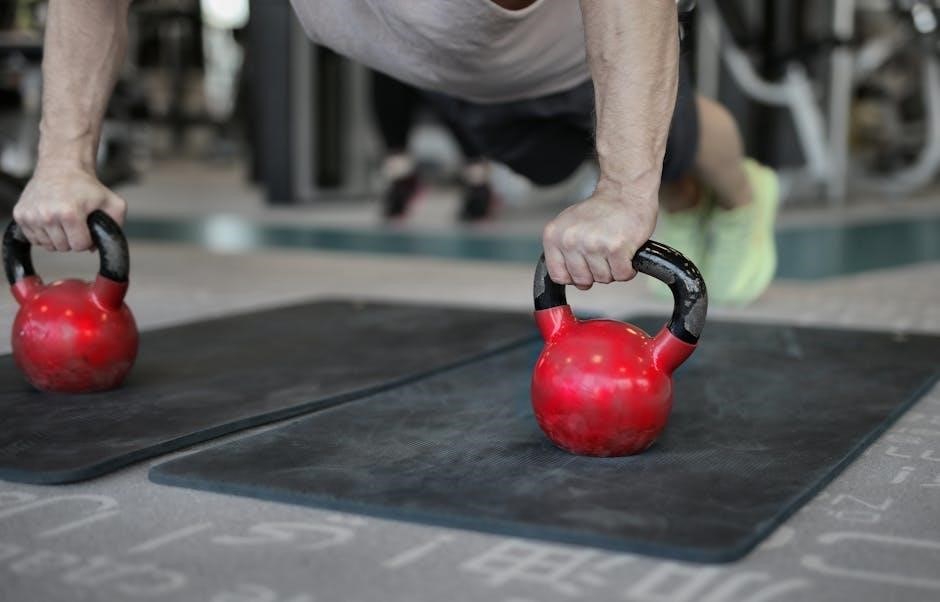Kettlebell workouts are versatile, efficient, and effective for building strength, power, and cardiovascular fitness. A PDF guide provides a structured plan with exercises, sets, and reps for all fitness levels, offering convenience and portability to train anywhere.
What is a Kettlebell Workout?
A kettlebell workout is a dynamic and efficient training method using a single weight with a handle, engaging multiple muscle groups simultaneously. It combines strength, endurance, and cardiovascular exercises, often in flowing movements. Kettlebell workouts are highly versatile, suitable for all fitness levels, and can be adapted to focus on specific goals like muscle building, fat loss, or improved mobility. The workouts are typically structured in circuits or sets, with timed intervals or rep-based routines. They are ideal for those seeking a time-efficient, full-body training option that can be performed anywhere, making them a popular choice for home, gym, or outdoor sessions.
Benefits of Kettlebell Training
Kettlebell training offers numerous benefits, including improved strength, power, and cardiovascular fitness. It engages multiple muscle groups simultaneously, making it a highly efficient full-body workout. The dynamic movements enhance coordination, balance, and mobility while burning calories at a high rate—up to 400 calories in 20 minutes. Kettlebells are portable, allowing workouts anywhere, and their versatility suits various fitness levels and goals, whether building muscle, losing fat, or boosting endurance. The functional nature of kettlebell exercises also improves core stability and overall athleticism, making it an excellent addition to any fitness routine. This time-efficient training method is ideal for those seeking a comprehensive and effective way to enhance physical fitness.
Structure of a Kettlebell Workout Plan
A well-structured kettlebell workout plan typically includes full-body, push-pull-legs, or upper-lower splits, with clear sets, reps, and timing. A warm-up routine is essential for preparation, while a PDF guide ensures organization and progress tracking, making workouts efficient and goal-oriented.
Full-Body Workout
A full-body kettlebell workout engages multiple muscle groups simultaneously, enhancing strength, endurance, and coordination. It typically includes exercises like swings, goblet squats, and presses, targeting the entire physique. Beginners can start with basic movements, progressing to more complex ones as they build proficiency. The portability of kettlebells allows for these workouts to be done anywhere, making them ideal for home or gym use. Incorporating a full-body routine into a PDF guide ensures consistency and structure, helping individuals achieve their fitness goals efficiently. This approach is both time-effective and comprehensive, making it a popular choice among fitness enthusiasts of all levels.
Push, Pull, Legs Split
The Push, Pull, Legs split is a structured approach to kettlebell training, dividing workouts into three focused days. Push day targets muscles like the chest, shoulders, and triceps with exercises such as kettlebell presses and lateral raises. Pull day emphasizes the back, biceps, and forearms through exercises like bent-over rows and snatches. Legs day strengthens the lower body with goblet squats, lunges, and swings. This split allows for balanced development and recovery, making it ideal for intermediate lifters. A PDF guide can outline the exercises, sets, and reps for each day, ensuring a clear and progressive plan to build overall strength and muscle mass effectively. This method promotes consistency and helps avoid overtraining while maximizing results;
Upper-Lower Split
The Upper-Lower Split is a popular training approach that divides workouts into upper body and lower body days. This method allows for focused training on specific muscle groups, promoting balanced development and recovery. On upper body days, exercises like kettlebell shoulder presses, bent-over rows, and snatches are used to target the chest, back, and arms. Lower body days focus on goblet squats, front rack reverse lunges, and kettlebell swings to build strength in the legs and glutes. A PDF guide can provide a detailed 4-day plan, alternating between upper and lower body workouts. This split is ideal for those seeking a structured yet flexible routine to enhance overall strength and muscle endurance.
Warm-Up Routine
A proper warm-up is essential to prepare the body for a kettlebell workout. It increases heart rate, enhances blood flow, and reduces the risk of injury. Begin with light cardio such as jogging in place or jumping rope for 5-10 minutes. Follow with dynamic stretches like arm circles, leg swings, and torso twists to improve mobility. Incorporate kettlebell-specific movements, such as halos and gentle swings, to activate the shoulders, hips, and core. A structured warm-up routine in a PDF guide ensures a smooth transition into the workout, optimizing performance and safety; This preparation is crucial for maximizing the effectiveness of subsequent exercises and preventing injuries.

Popular Kettlebell Exercises
Popular kettlebell exercises include swings, goblet squats, shoulder presses, bent-over rows, and front rack reverse lunges. These movements are highly effective for full-body strength and conditioning, making kettlebell training time-efficient and versatile.
Kettlebell Swing
The kettlebell swing is a foundational exercise that combines strength and cardio, making it a cornerstone of many kettlebell workout plans. To perform a swing, hinge at the hips, swing the kettlebell back between your legs, then explosively thrust your hips forward to drive the kettlebell to chest height. Keep your core tight and arms relaxed, focusing on generating power from your hips. This movement targets the hamstrings, glutes, and core muscles while improving coordination and explosive power. Incorporating swings into your routine enhances full-body strength and cardiovascular fitness, making it a highly efficient exercise for any fitness level. It’s often included in PDF guides due to its simplicity and effectiveness.
Goblet Squats
The goblet squat is a fundamental exercise in kettlebell training, focusing on lower-body strength and mobility. To perform it, hold the kettlebell close to your chest with both hands, elbows tucked in. Descend into a squat, keeping your back straight and knees tracking over your toes. Lower until your elbows gently touch your knees, then press through your heels to return to a standing position. This exercise targets the quadriceps, hamstrings, and glutes while improving core stability and squat technique. It’s an excellent movement for building functional strength and is often included in PDF workout guides due to its simplicity and effectiveness for all fitness levels. Regular practice enhances overall lower-body power and mobility.
Kettlebell Shoulder Press
The kettlebell shoulder press is an excellent exercise for building upper-body strength, particularly targeting the deltoids and triceps. To perform it, hold the kettlebell at shoulder height with both hands, resting it against your chest. Press the kettlebell overhead until your arms are fully extended, then lower it back to the starting position. This exercise is often included in PDF workout guides due to its effectiveness in improving shoulder stability and overall pressing power. It can be performed with one or two kettlebells, making it versatile for different fitness levels. Consistent practice enhances shoulder development and contributes to a stronger upper body. Proper form is essential to avoid injury and maximize results.
Bent Over Row
Bent Over Row
The bent over row is a fundamental kettlebell exercise that targets the latissimus dorsi, rhomboids, and biceps. To perform it, hold a kettlebell with both hands, bend at the hips, and keep your back straight. Let the kettlebell hang below your hips, then pull it towards your lower ribcage, squeezing your shoulder blades together. Lower the kettlebell back to the starting position and repeat. This exercise is commonly featured in PDF workout guides due to its effectiveness in building back strength and improving posture. Proper form is crucial to avoid strain and ensure a full range of motion. Regular practice helps enhance overall upper-body muscle development and functional strength.
Front Rack Reverse Lunge
The front rack reverse lunge is a dynamic kettlebell exercise that targets the quads, hamstrings, and glutes while improving balance and coordination. Hold the kettlebell at shoulder height with both hands, resting it against your chest. Step backward into a lunge, keeping your front knee at 90 degrees and your back knee nearly touching the ground. Ensure your chest stays upright and your core is engaged. Push through your front heel to return to the starting position. This exercise is often included in PDF workout guides due to its effectiveness in building lower-body strength and stability. It is particularly beneficial for enhancing functional movement and overall leg development. Proper form is essential to prevent injury and maximize results.

Creating a PDF Kettlebell Workout Guide
A well-structured PDF guide includes clear workout plans, sets, reps, and timing. It ensures clarity, with start and end times, and focuses on long-term goals for consistency and progress.

How to Design a Workout Plan
Designing a kettlebell workout plan involves defining clear goals, such as strength, endurance, or weight loss. Start by selecting exercises that target specific muscle groups, ensuring a balanced approach. Organize workouts into splits, such as full-body, upper-lower, or push-pull-legs, to optimize recovery. Assign sets, reps, and weights based on objectives, with strength-focused plans using lower reps and heavier weights. Include warm-up routines and nutritional advice for maximum efficiency. Timing is crucial, with circuits or timed sets to enhance cardiovascular benefits. Ensure the plan progresses gradually, increasing intensity over weeks. Finally, add visual aids and tips for proper form to prevent injuries and maximize results. A well-designed plan ensures consistency and progress.

Including Sets, Reps, and Timing
In a PDF kettlebell workout guide, specifying sets, reps, and timing is essential for clarity and effectiveness. Strength-focused exercises typically include 3-5 sets of 5-8 reps, while endurance training may involve higher reps (10-15) with shorter rest periods. Timing plays a crucial role in circuit-based workouts, where exercises are performed back-to-back with minimal rest. For example, a 20-minute AMRAP (As Many Rounds As Possible) format maximizes calorie burn and cardiovascular benefits. Including timing guidelines ensures workouts are efficient and goals-oriented, whether aiming for muscle building, fat loss, or improved conditioning. Clear instructions on sets, reps, and timing help users stay on track and achieve optimal results. This structured approach makes kettlebell training accessible and effective for all fitness levels.
Adding Visual Demonstrations
Including visual demonstrations in a PDF kettlebell workout guide enhances clarity and understanding. High-quality images or diagrams of proper form and technique ensure users can mimic exercises accurately, reducing the risk of injury. Videos or links to video tutorials can also be embedded for dynamic demonstrations. Visual cues, such as arrows indicating movement direction or highlighted muscle engagement, further aid comprehension. For complex movements like the kettlebell swing or clean, step-by-step illustrations are particularly beneficial. Visuals make the guide more engaging and accessible, especially for beginners. They also serve as a quick reference point during workouts, helping users maintain proper form and technique consistently. This visual support elevates the effectiveness of the workout plan and user experience.
Safety Tips for Kettlebell Workouts
Prioritize proper form and technique to avoid injuries. Start with lighter weights to build control and strength. Warm up thoroughly to prepare muscles and joints. Choose weights that challenge you without compromising form. Rest adequately between sets and avoid overtraining. Focus on controlled movements to prevent strain.

Proper Form and Technique
Maintaining proper form and technique is essential for safe and effective kettlebell workouts. Start with lighter weights to master movements like swings, squats, and presses. Engage your core to stabilize and protect your lower back. Avoid rounding your back during exercises; keep it neutral or slightly arched. Ensure smooth, controlled transitions between movements to prevent strain. Focus on full-range motion without sacrificing form for heavier weights. Practice each exercise slowly to build muscle memory and strength. Proper technique not only enhances results but also minimizes injury risk, allowing you to progress safely and efficiently in your training.
Choosing the Right Weight
Selecting the appropriate kettlebell weight is crucial for both safety and effectiveness. Start with a lighter weight to master proper form and technique, especially if you’re new to kettlebell training. Consider your fitness level and the specific exercise—swings and cleans may require heavier weights, while presses and overhead movements need lighter ones. For most beginners, an 8-12 kg (18-26 lbs) kettlebell is a good starting point. Gradually increase the weight as your strength and confidence grow. Using a weight that’s too heavy can lead to poor form and injury, while too light may not challenge your muscles adequately. Always consult a PDF guide for weight recommendations tailored to your workout plan.

Preventing Injuries
Preventing injuries in kettlebell workouts requires attention to proper form, warm-up routines, and progressive overload. Start with a dynamic warm-up, including arm circles, leg swings, and light cardio, to prepare your muscles and joints. Focus on maintaining proper posture and engaging your core during exercises to avoid strain. Avoid using weights that are too heavy too soon, as this can lead to poor form and injury. Gradually increase the intensity and weight as your strength improves. Rest between sets and avoid overtraining to allow your body to recover. Additionally, ensure your kettlebell has a smooth, even handle to prevent hand injuries. Always prioritize technique over weight to stay safe and effective.
Kettlebell workouts offer a time-efficient, portable, and versatile way to improve strength, power, and cardiovascular fitness. Whether you’re a beginner or advanced, a well-structured PDF guide provides clear plans and exercises to suit your goals. By incorporating full-body movements and targeted splits, kettlebell training enhances overall athleticism and burns calories effectively. Consistency and proper form are key to maximizing results while preventing injuries. With a variety of routines available, from 4-week beginner plans to advanced complexes, kettlebell workouts are adaptable to any fitness level. Download a comprehensive PDF guide to unlock a structured approach to achieving your fitness goals and transforming your physique.